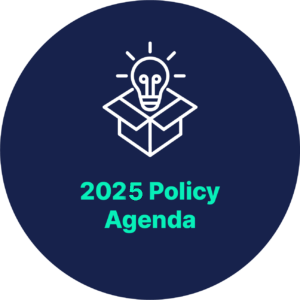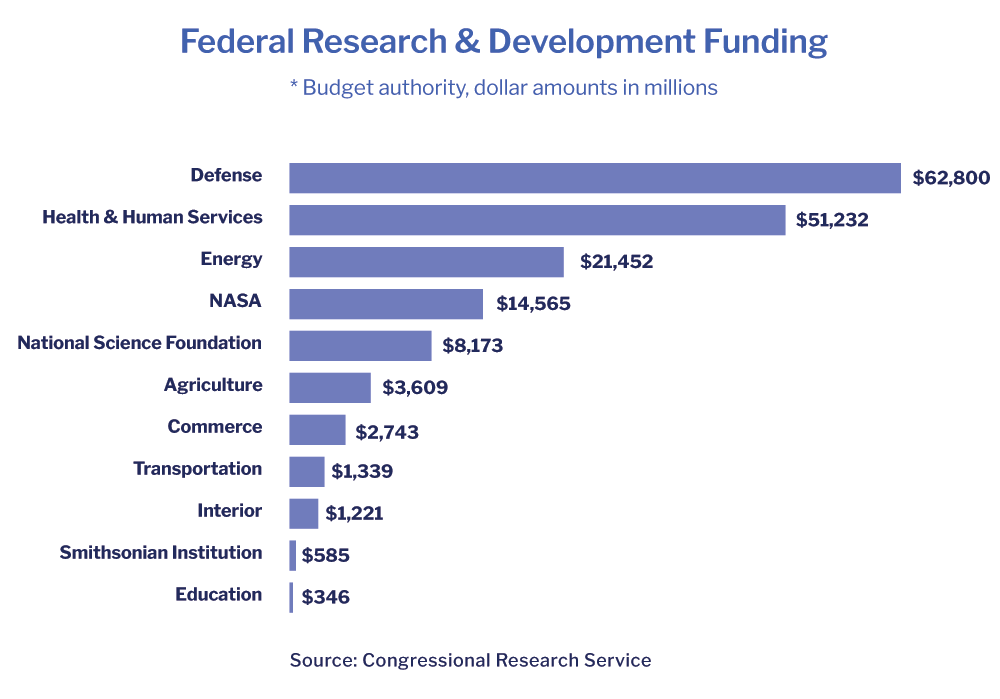Presidential Memo – 2025
November 12, 2024 |
Bold Leadership for K-12 Education
In the Next 100 Days

How the Trump Administration Can Advance a Student-Centered Innovation Agenda
Since the late 1800s, our nation’s school system has been oriented around an individual teacher guiding a cohort of same-aged students through a standardized curriculum. This industrial paradigm, built on principles of efficiency and standardization to support factory jobs, remains unchanged more than a century later.
As a result, the U.S. education system faces a series of crises. The industrial paradigm pushes students through to the next grade, regardless of whether they achieve mastery, allowing unfinished learning to grow, imperiling their chances of success in the future. When students miss fundamental concepts in key developmental years, they fall further behind without any mechanism for catching up.
For students who make it to graduation, just one in three students are prepared for college or a career. Chronic absenteeism further deepens a cycle of missed learning and disengagement. Parent frustration with rigid and unresponsive interventions reflect a larger trend of public dissatisfaction with K-12 public schools. Teachers, asked to do more than ever, recognize that students are not receiving the support they need to thrive in the 21st century economy.
Failure to act threatens to weaken America’s global competitiveness and workforce readiness. Future projections by Stanford University economist Eric Hanushek show a potential $31 trillion loss in GDP this century due
to diminished student skills, with dire consequences for key industries like STEM and manufacturing.
Schools and districts cannot shift away from the industrial paradigm on their own. To fundamentally change how the classroom works, strong leadership from the federal government is needed more than ever. The next administration can lead the way by building an education infrastructure for innovation. By working with Congress, the executive branch should support specific policies and initiatives that invest in new approaches to teaching and learning, reduce barriers which inhibit progress, and create space for innovation.
A Student-Centered Federal Blueprint
Invest in New Approaches to Teaching & Learning
- Create the National Center for the Advanced Development in Education (NCADE)
- Make bold federal investments that prioritize the development in R&D
- Fund and build the Centers for Transformative Education Research and Translation (CTERTs)
Remove Barriers for Innovation in Assessment & Accountability
- Fix the Innovative Assessment Demonstration Authority (IADA)
- Ensure innovative yet rigorous provisions in a competency-based accountability system
- Set parameters for a state’s proposed competency-based assessment system
Invest in New Approaches to Teaching and Learning
Sectors such as energy, healthcare, and defense have existing federal ecosystems to support breakthrough research and development, adoption, and systemic advancement. No such equivalent exists in K-12 education. The next administration can help lay the groundwork needed to develop paradigm-shifting ideas for education.

Create the National Center for the Advanced Development in Education (NCADE)
The next administration should establish a new federal center such as the National Center for Advanced Development in Education (NCADE) within the Institute of Education of Sciences (IES) focused on developing innovative, scalable solutions that address the greatest challenges in the U.S. school system.
Why it’s needed
In 2001, the federal government authorized $264 million on education research and development—dead last among all federal agencies. It was even lower in 2020 (and still dead last). Of that, a small fraction goes to actually developing and implementing new approaches for practical use in classrooms.
A Good Start?
In 2023, Congress directed IES to invest in “quick-turnaround high- reward, scalable solutions” to improve education outcomes for all learners. The resulting Seedlings to Scale Grants program is the first of its kind, but its initial annual funding levels—$30 million—falls short of what is needed.
Legislative Action Step
The next administration should support, advocate, and budget for the passage of the New Essential Education Deliveries (NEED) Act, which authorizes the creation of, and funding for, NCADE. The NEED Act would allow NCADE to support large-scale, innovative projects that require a more nimble and responsive program management approach than is currently in place.
Mirroring the ARPA Infrastructure for K-12 Education
A center such as NCADE would mirror successful federal R&D ecosystems in other sectors. The ARPA infrastructure, modeled after the Defense Advanced Research Projects Agency (DARPA), creates space to “fail fast” and develop scalable solutions that address longstanding deficits and inequities.
- Since 1958, DARPA has fueled early investments in science and technology to improve national security
- In healthcare, the National Institute of Health (NIH) is the largest public funder of biomedical research in the world, funding early-stage and long-term developments.
- The energy sector leverages billions in private capital and public investment in order to drive the transformation toward renewables.


Make bold federal investments that prioritize the development in R&D
Establishing a center such as NCADE lays the foundation for a robust R&D ecosystem, but it will not have a transformative impact without dramatic and sustained funding from the federal government. To develop and implement transformative
education models and tools that improve student outcomes, the next administration can play a leading role in supporting long-term investments for specific initiatives under the new authority of a center such as NCADE.
Why it’s needed
Advancements in technology and artificial intelligence are rapidly transforming what students need to know and be able to do. A robust R&D ecosystem must receive sustained investments to develop and scale innovative, flexible approaches—such as innovative learning models (ILMs)—that will meet students where they are and help them develop career-ready skills and knowledge. Specifically, ILMs are designed to help move to individualized and responsive learning in order to help students get back on track and meet the needs of the 21st century skilled workforce.
Legislative Action Step
Work with Congress to pass the Developing and Advancing Innovative Learning Models Act, which authorizes $570 million in annual competitive funding for ten years to support ILM development, organizational capacity, and research into ILM’s impact on student outcomes; and $180 million in annual formula funding in the U.S. Department of Education (USED) to support state and local adoption of ILMs.
What are Innovative Learning Models?
Innovative Learning Models, or ILMs, are bundles of integrated tools, resources, systems, and teaching practices that enable schools to provide individual students with an educational program that’s right for them given where they are, and where they need to be—ultimately to be college- and career-ready.
ILMs are supported by national unions, state superintendents, and teacher advocacy groups alike because they are holistic, school-based programs that help educators facilitate a personalized approach to education.
Fund and build the Centers for Transformative Education Research and Translation (CTERTs)
The National Science Foundation (NSF) can serve as an essential implementation partner to IES. The CHIPs and Sciences Act specifically authorized the Centers for Transformative Education Research and Translation (CTERTs) to allow for NSF to make grant awards that support R&D for K-12 education solutions, with a special focus on implementing evidence-based STEM practices, models, programs, curriculum, and technologies. However, nearly two years after passage of the legislation, CTERTs has yet to be fully established as a core component of the federal R&D ecosystem.
Why it’s needed
Aligning CTERTs to NCADE can better support the implementation and scaling of education tools, including innovative learning models, ultimately developed by leveraging existing NSF partnerships with states and schools. More touch points and feedback loops across federal agencies will also ensure that STEM education discoveries and tools, such as innovative learning models, can be developed into real solutions for learners.
Remove barriers and create space for innovation in assessment and accountability
Current federal assessment and accountability policies prioritize the results of annual grade-level tests. This is a disincentive to meeting individual student needs, impeding progress toward a student-centered education paradigm.
To drive this shift, the next administration should work with Congress to allow states to adopt competency-based assessment and accountability systems. This approach would encourage innovation while maintaining
essential safeguards established by the Every Student Succeeds Act (ESSA). Critically, this work will help create a body of high-quality evidence to inform reauthorization of the Elementary and Secondary Education Act (ESEA) and larger systemic change.
Support and implement a competency-based assessment system within an amended IADA
The next administration should support efforts by Congress to add a competency-based assessment system pilot to the Innovation Assessment Demonstration Authority (IADA).
Why it’s needed
The next administration should support efforts by Congress to add a competency-based assessment system pilot to the Innovation Assessment Demonstration Authority (IADA).
What is the Innovative Assessment Demonstration Authority?
The Innovative Assessment Demonstration Authority, or IADA, was authorized in 2015 through ESSA to allow up to seven states to design and pilot different types of summative assessments while maintaining accountability for all students. Nearly 10 years after the creation of IADA, inadvertent program limitations have not
supported the flexibility necessary to successfully test and implement new assessments. As a result, several states have withdrawn from the assessment pilots. In addition, no new states have applied to participate in IADA during the last two application windows in 2023 and 2024, despite recent clarifications made by USED in November of 2023.
Work with Congress to ensure innovative yet rigorous accountability provisions in the competency-based assessment pilot
Current federal accountability metrics are still designed to record student growth based on the results of grade-level assessments. Creating innovative accountability systems under IADA is essential for providing participating states flexibility to measure progress across grade levels and better identify individual student needs. However, the next administration should also work with Congress to maintain strong protections and safeguards for all students. Schools participating in the competency-based assessment pilot should be required to administer grade-level assessments in certain grades and know where students are relative to grade-level proficiency. Disaggregated reporting on student performance will also provide greater information and transparency on progress towards mastery of state academic standards.
Why it’s needed
Accountability based solely on annual grade-level test results can stifle education innovation, but these policies have helped to shine a light on systemic inequities. Strong accountability provisions for a competency-based assessment system will allow parents, school leaders, and policymakers to have better information on how schools are doing at their job of educating students.
Provide states with strong oversight, support, and funding for developing and implementing a competency-based assessment system
The next administration should work with Congress to set parameters for reviewing a state’s proposed competency-based assessment system. State proposals should include a detailed plan and receive approval by USED before participating in the pilot through IADA.
The next administration should also call for a new peer review process that accommodates assessments that meet students where they are in their learning journey by measuring mastery on off-grade and on-grade items.
Finally, USED should prioritize existing funds through the Competitive Grants for State Assessments (CGSA) for states that apply for the competency-based assessment pilot. This use of CGSA funding aligns well with Section 1201 in ESSA, which emphasizes evaluating student academic achievement through the development of competency-based assessments.
Why it’s needed
The IADA competency-based pilot must be implemented with fidelity, beginning with consistent parameters established for implementation. This necessary step will allow for the collection of a robust and high-quality evidence base that will ultimately ultimately inform reauthorization of ESEA and larger systemic change.

Stay informed.
Get involved.
Join the dialogue and reimagine education.